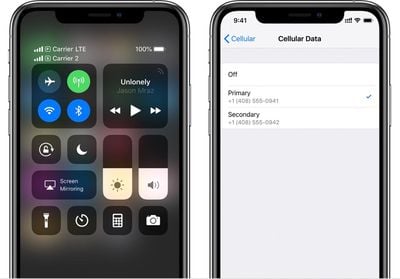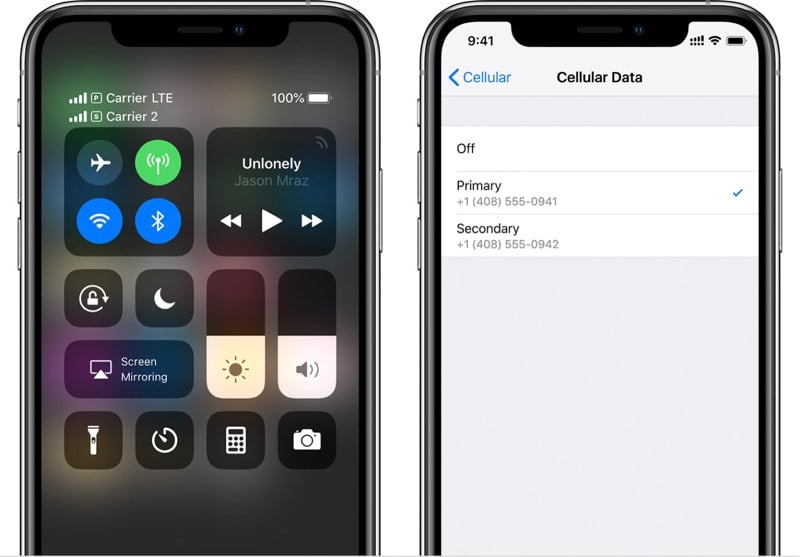AT&T in US, Rogers and Fido in Canada, and Many Other Carriers Rolling Out eSIM Support on Latest iPhones
Coinciding with today's release of iOS 12.1.1, additional carriers around the world are enabling eSIM support on the iPhone XS, iPhone XS Max, and iPhone XR, allowing for dual-SIM functionality on those devices.

According to Apple's website, the latest carriers supporting the eSIM feature include AT&T in the United States; Rogers and Fido in Canada; 3 in Denmark and Sweden; Orange in Poland and Spain; Telia in Estonia and Finland; Telenor in Norway; Swisscom and Sunrise in Switzerland; Vodafone in Qatar; and select others.
In Asia, the eSIM feature can now be used with 1010, CSL, China Mobile, and SmarTone in Hong Kong; M1 in Singapore; APT in Taiwan; Airtel and Reliance Jio in India; and AIS, dtac, and True Move in Thailand.
AT&T's website confirms that it supports eSIM on the latest iPhones as of iOS 12.1.1, while Apple's website continues to state that Verizon and T-Mobile will offer eSIM service "later this year." We've heard from a few people that Verizon may enable support on Friday, but this is strictly word of mouth.
It seems that the rollout of eSIM functionality on iPhones is hit or miss at this point, as a MacRumors tipster claims to have set up eSIM with T-Mobile on the new 12.9-inch iPad Pro, while others have had no luck. The ball is definitely rolling, though, so hopefully eSIM support is more widespread by year's end.
The eSIM, or digital SIM, is a non-physical SIM card slot that pairs with the physical SIM card in the iPhone XS, iPhone XS Max, or iPhone XR to enable dual-SIM dual-standby, a feature that lets iPhone users have two phone numbers available at once — useful for travel or both personal and work lines on a single iPhone.
Popular Stories
Apple is not expected to release a standard iPhone 18 model this year, according to a growing number of reports that suggest the company is planning a significant change to its long-standing annual iPhone launch cycle.
Despite the immense success of the iPhone 17 in 2025, the iPhone 18 is not expected to arrive until the spring of 2027, leaving the iPhone 17 in the lineup as the latest...
Apple's restrained artificial intelligence strategy may pay off in 2026 amid the arrival of a revamped Siri and concerns around the AI market "bubble" bursting, The Information argues.
The speculative report notes that Apple has taken a restrained approach with AI innovations compared with peers such as OpenAI, Google, and Meta, which are investing hundreds of billions of dollars in data...
The company behind the BlackBerry-like Clicks Keyboard accessory for the iPhone today unveiled a new Android 16 smartphone called the Clicks Communicator.
The purpose-built device is designed to be used as a second phone alongside your iPhone, with the intended focus being communication over content consumption. It runs a custom Android launcher that offers a curated selection of messaging...
The Apple Fitness+ Instagram account today teased that the service has "big plans" for 2026. In a video, several Apple Fitness+ trainers are shown holding up newspapers with headlines related to Apple Fitness+.
What's Apple Fitness+ Planning for the New Year?
Something Big is Coming to Apple Fitness+
The Countdown Begins. Apple Fitness+ 2026 is Almost Here
2026 Plans Still Under ...
Apple hasn't updated the Mac Pro since 2023, and according to recent rumors, there's no update coming in the near future. In fact, Apple might be finished with the Mac Pro.
Bloomberg recently said that the Mac Pro is "on the back burner" and has been "largely written off" by Apple. Apple apparently views the more compact Mac Studio as the ideal high-end pro-level desktop, and it has almost...
Apple today added the final 13-inch MacBook Air powered by Intel processors, the Apple Watch Series 5, and additional products to its vintage products list. The iPhone 11 Pro was also added to the list after the iPhone 11 Pro Max was added back in September.
The full list of products added to Apple's vintage and obsolete list today:
MacBook Air (Retina, 13-inch, 2020)
iPhone 8 Plus 128GB ...
Apple today announced a number of updates to Apple Fitness+ and activity with the Apple Watch.
The key announcements include:
New Year limited-edition award: Users can win the award by closing all three Activity Rings for seven days in a row in January.
"Quit Quitting" Strava challenge: Available in Strava throughout January, users who log 12 workouts anytime in the month will win an ...
iPhone 17 Pro and Pro Max owners are having trouble with the speakers of their devices, and have complained about a static or hissing noise that occurs when the iPhone is charging.
There are multiple discussions about the issue on Reddit, the MacRumors forums, and Apple's Support Community, where affected users say there is a noticeable static noise "like an old radio." Some people report...











 ('https://www.macrumors.com/2018/12/05/iphone-esim-att-rogers-fido-canada/')
('https://www.macrumors.com/2018/12/05/iphone-esim-att-rogers-fido-canada/')













